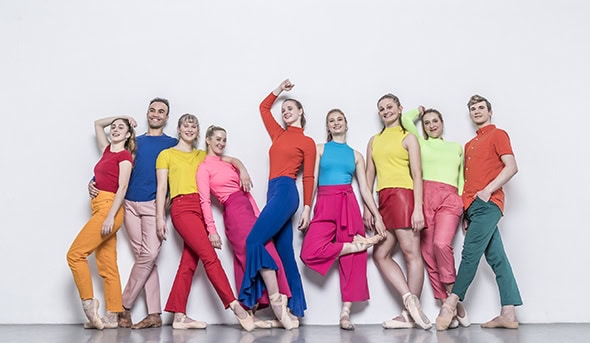Images Ballet Company 2019 at Lilian Baylis Theatre
Posted: September 5th, 2019 | Author: Nicholas Minns & Caterina Albano | Filed under: Performance | Tags: Andrew McNicol, Ashley Page, Cameron McMillan, Images Ballet Company, Jennifer Jackson, London Studio Centre | Comments Off on Images Ballet Company 2019 at Lilian Baylis TheatreImages Ballet Company at Lilian Baylis Theatre, June 19

Finding a fresh end-of-year performance repertoire for students in the final year of London Studio Centre’s classical ballet strand is fraught with compromise. While classical ballet may be central to the curriculum, the classical form in contemporary performance is subject to various challenges, from inadvertent misunderstanding to intentional mishandling. With four new works to commission for her London Studio Centre students, Images Ballet Company artistic director Jennifer Jackson is well suited to navigating the hazardous paths to its realization. Having been a soloist in the Royal Ballet and subsequently experimented in choreographing the classical form and engaged in teaching its essentials ever since, she knows how to stand her ground and is not one to follow trends. She is careful to avoid, for example, the existential threat to the classical form at her former company arising from the dis-location of the body in the choreography of Wayne McGregor. Nevertheless, she faces two issues that this end-of-year performance aims to resolve. The number of choreographers working in the classical idiom is as limited as her budget so while she can at times access the talents of some of her more experienced colleagues, she must judge the input of less well-established choreographers to make up a program that will show off the quality of her dancers to their highest standards. That Jackson succeeds in balancing these competing demands is testimony to her skill in the artistic equivalent of realpolitik.
One aspect of the performance Jackson has developed during her tenure at London Studio Centre is the musical through-line. This year composer and percussionist Martin Pyne provides not only a virtuosic composition for Mikaela Polley’s Interplay that he performs on stage, but a witty trio with himself on a mini-piano and two dancers that is performed during the intermission as an impromptu work in itself. Pyne begins Interplay seated behind his drum kit on an empty stage, giving us a foretaste of rhythmic patterns and percussive sounds for the choreography to follow. If Polley is conversant with classical technique, the forms and underlying rhythms she has chosen for the dancers are no match for Pyne’s virtuosic playfulness. Unlike the tradition in Indian classical dance, its western counterpart lacks the training of an integrated, percussive dynamic between musicians and dancers; although the interplay is present in the communication between Pyne and the dancers, the choreographic effect falls short of its promise. At the end, the gradual dismantling of the drum kit by the dancers while Pyne continues playing undaunted is a gem of musical and virtuosic wit.
Andrew McNicol’s Mirrors is a trio, a welcome relief from the habitual form of end-of-year performances where everyone appears in all the works. McNicol trained at The Royal Ballet School where he won the Kenneth MacMillan Choreographic Competition and clearly has an understanding of classical technique. Mirrors, to the third and fourth movements from Ravel’s Miroirs for solo piano, is an impressionistic portrait of three women that never quite frames them. As long as dance is the physical expression of emotions it cannot be abstract, but if the expression is not clear the choreography will be bewildering. Mirrors has no story but its spatial and gestural intent is dissipated in this lack of clarity.
One of the misunderstandings about classical choreography is the over dependence on the signification of its shapes; just as music exists in between notes, dance happens in between shapes. Cameron McMillan’s On Lineage relies on classically trained dancers’ shapes in movement but leaves out the dance. The choreography is perhaps too influenced by Ezio Bosso’s saccharine music (from Six Breaths and Music for Weather Elements) that uses successions of chords in a similar way. It is the kind of work, however, that can bring individual presence into relief, as is the case with Daisy Bishop, whose transformation as a performer from last year is testament to the value of Jackson’s tenure at London Studio Centre.
It is Ashley Page’s Meadowdown that finally sets the dancers free as if the previous works had been a preparation; with a strong sense of classical technique within a contemporary form, Meadowdown soaks up the selection of music from Benjamin Britten’s lively Diversions for Piano (Left Hand) and Orchestra and translates it into a dynamically rich choreography that sets the stage dancing. Page writes that the work has been created ‘to reveal the students as they discover themselves in performance’ and that’s exactly what it does.